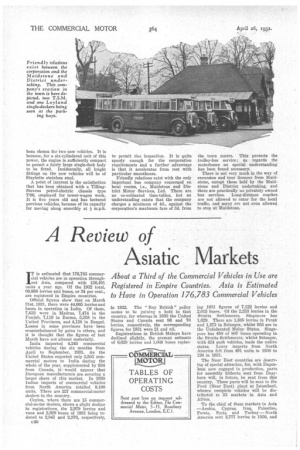A Review of
Page 62

Page 63

If you've noticed an error in this article please click here to report it so we can fix it.
Asiatic Markets
IT is estimated that 176,783 commercial vehicles are in operation throughout Asia, compared with 156,491 units a year ago. Of the 1932 total, 60,956 lorries and buses, or 34 per cent., are registered in Empire countries.
Official figures show that on March 31st, 1931, there were 44,665 lorries and buses in operation in India. Of these, 7,632 were in Madras, 7,474 in the Punjab, 7,119 in Burma, 5,258 in the United Provinces, and 4,128 in Bengal. Losses in some provinces have been counterbalanced by gains in others, and it is thought that the figures of last March have not altered materially.
India imported 4,245 commercial vehicles during the six months from April to September, 1931. As the United States exported only 3,503 commercial motors to India during the whole of the year, supplemented by 934 from Canada, it would appear that European manufacturers are securing a larger share of this market. In 1930 Indian imports of commercial vehicles from North America totalled 9,100 units. There are 227 commercial-motor dealers in the country.
Ceylon, where there are 15 commercial-motor dealers, shows a slight decline in registrations, the 2,979 lorries and vans and 2,629 buses of 1931 being reduced to 2,947 and 2,376, respectively, c40
In 1932. The " Buy British" policy seems to be gaining a hold in that country, for whereas in 1930 the United States and Canada sent 96 and 70 lorries, respectively, the corresponding figures for 1931 were 21 and nil.
Registrations in British Malaya have declined slightly, the present estimate of 6,620 lorries and 1,069 buses replac
ing 1931 figures of 7,122 lorries and 2.015 buses. Of the 2,253 lorries in the Straits Settlements, Singapore has 1,629. There are 1,385 lorries in Perak and 1,273 in Selangor, whilst 955 are in the Unfederated Malay States. Singapore has 450 of 807 buses operating in the Straits Settlements, whilst Selangor, with 424 such vehicles, leads the native states. Lorry imports from North America fell from 491 units in 1930 to 126 in 1931.
The Near East countries are deserving of special attention, for, with Dagenham now engaged in production, parts for assembly hitherto sent from Dearborn will, in future, be sent from this country. These parts will be sent to the Ford (Near East) plant at Istamboul, whence complete vehicles will be distributed to 23 markets in Asia and Africa.
To the chief, of these markets in Asia —Arabia, Cyprus, Iraq, Palestine, Persia, Syria and Turkey — North America sent 2,777 lorries in 1930, and a further 1,021 in 1931, but„ with the end of the world-wide depression and a common desire for development, exports to these countries may shortly be expected materially to increase.
The latest information shows that about250commercial vehicles are ()whiting itt Arabia, 1,500 in Cyprus, 1,275 in.-Iraq, 1,350 in Palestine, 5,400 in Persia, ,2,763 in Syria and 3,900 in Turkey. Teheran has 1,440 lorries and 220 buses, whilst 300 lorries and 107 buses are operating in Istamboul. The above .figures include 800 buses in the case of Palestine, 400 in Persia and 1,900 in Turkey.
Despite the fact that Syria is a French mandate, it has remained an open market. This accounts for the fact that 405 of the 600 lorries imported last year-caine from the United States. It is anticipated that 650 lorries and buses will be sold in Syria during 1932.
Japanese commercial-vehicle registrations are estimated to have increased from 39,937 in 1931 to 43,200 in 1932, and of the latter total some 4,000 units are in Korea, Formosa and other adja
cent territories. The trade is handled by 42 commercial-motor dealers. Lorry imports from the United States rose from 2,304 units in 1930 to 4,280 in 1931, the increase probably being due to military requirements.
The recent disturbances in Manchuria have made it difficult to compute motor registrations, but it is estimated that there are now 530 'lorries and 1,683 buses in this territory. The trade IS in the hands of 21 dealers.
China is another country where particulars were difficult to obtain, but probably totals of 6,000 lorries and 4,000 buses are not far from the mark. Last year China took 552 lorries from the United States and 70 from Canada, against 911 and 145, respectively, in 1930.
The number of lorries in the Philippine Islands increased from 14,380 in 1931 to 14,750 in 1932. This archipelago being under the protection of the United States, there is little opportunity for any other country to secure a footing. This is instanced by the latest trade figures. During the first 10 months of last year the Philippines imported 1,550 lorries, whilst the United States claims that during 1931 it sent 1,518 of these to the islands.
Estimates of 16,648 lorries and 5,826 buses are given for the Dutch East Indies. Java is said to have 5,551 lorries and 2,53:3 buses, Sumatra 9,524 lorries and 2,261 buses, and the outer islands 1,573 lorries and 1,032 buses. In the group there are 113 agents.
French Indo-China is a closed market. Even the United States has passed only 56 lorries through this tariff wall during the past two years. Estimated registrations for 1932 are put at 2,039 lorries and 3,426 buses.
About 3,000 lorries and buses are reported to be registered in Siam. Imports declined materially last year, only 36 lorries being imported from North America, whilst in 1930 the figure was 147.
• Other Asiatic countries for which registration particulars are volunteered are : Afghanistan, 100 lorries; Brunei 19 lorries and 12 buses; and Tibet, 12 lorries.












































































































